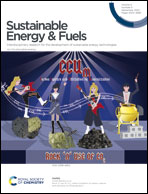Stress tolerance assessment of dibenzyltoluene-based liquid organic hydrogen carriers
Abstract
Hydrogen production from charged liquid organic hydrogen carrier (LOHC) systems is always a trade-off between the molecule's storage capacity and the stability over the numerous charging/discharging cycles. This is because deep dehydrogenation induces cracking of the molecule and thus the storage capacity could be compromised by partial dehydrogenation. It is crucial to optimize a hydrogenation system in order to avoid possible excessive exothermic temperature whilst maintaining a high degree of hydrogenation (doh). Pure dibenzyltoluene (H0-DBT) was hydrogenated up to 98% at a relatively low pressure of 15 barg (instead of at the frequently used 30–50 barg). We determined the number of cycles that a LOHC molecule can tolerate from the amount of by-products produced during each hydrogen charge/discharge cycle. If a limit of by-products is low such as in the case of toxic compounds if available, the LOHC duration of use will be short. A higher limit for LOHC based by-products suggests a long duration of usage. Furthermore, in the absence of any by-products, the LOHC molecule usage could be endless. This certainly depends on operating conditions, catalyst type and metal loading used. Accelerated stress tests were used to predict the time to failure of the LOHC molecule. Methane was obtained in the gas phase and the liquid by-products follow the increasing order: benzene < C21 < xylene < C13–C15 < toluene < H0-MBT. Indications were that the dibenzyltoluene based LOHC is quite stable because the amount of liquid by-products obtained under stress conditions is 7.4 mol%.



 Please wait while we load your content...
Please wait while we load your content...